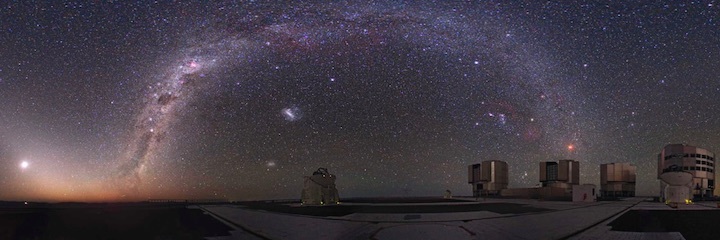24.05.2018
Based on new observational data, an international team led by ETH astronomers identified at least six candidates for 'dark galaxies' — galaxies that have a few (if any) stars in them and are, for that reason, notoriously difficult to detect with current instruments.

The Very Large Telescope (VLT) complex in the Atacama Desert of northern Chile.
(Photo: ESO / Y. Beletsky)
-
Despite substantial progress over the past half a century in understanding of how galaxies form, important open questions remain regarding how precisely the diffuse gas known as the ‘intergalactic medium’ is converted into stars. One possibility, suggested in recent theoretical models, is that the early phase of galaxy formation involves an epoch when galaxies contain a great amount of gas but are still inefficient at forming stars. Direct proof of such a ‘Dark Phase’ has been so far elusive, however — after all, dark galaxies do not emit much visible light. The observational discovery of such galaxies would therefore fill an important gap in our understanding of galaxy evolution.
There are ways to bring dark galaxies to lighten up though. An international team led by Dr. Raffaella Anna Marino and Prof. Sebastiano Cantalupo from the Department of Physics at ETH Zurich has now done just that and thus was able to search the sky for potential dark galaxies with unprecedented efficiency. And successfully so, as they report in a paper published today in The Astrophysical Journal: they have identified at least six strong candidates for dark galaxies.
To overcome the obstacle that their target objects are dark, the team used a flashlight of sorts, which came in the form of quasars. These emit intense ultraviolet light, which in turn induces fluorescent emission in hydrogen atoms known as the Lyman-alpha line. As a result, the signal from any dark galaxies in the vicinity of the quasar gets a boost, making them visible. Such ‘fluorescent illumination’ has been used before in searches for dark galaxies, but Marino et al. now looked at the neighbourhood of quasars at greater distances than has been possible in earlier observations.

(Credit: R. A. Marino / MUSE)
Also, they acquired the full spectral information for each of the dark-galaxy candidates. Deep observations — 10 hours for each of the six quasar fields they studied — enabled Marino and her colleagues to efficiently tell dark-galaxy candidates apart from other sources. From initially 200 Lyman-alpha emitters, half a dozen regions remained that are unlikely to be normal star-forming stellar populations, making them robust candidates for dark galaxies.
The advances in observational capability have become possible thanks to the Multi Unit Spectroscopic Explorer (MUSE) instrument at the Very Large Telescope (VLT) of the European Southern Observatory (ESO) in Chile. In essence, previous studies were limited to imaging a relative narrow band of frequencies, for which specific filters had to be designed. The MUSE instrument instead allowed hunting ‘blindly’ — without filters — for dark galaxies around quasars at larger distances from Earth than had been possible so far.
This work is a collaboration between researchers at ETH Zurich, Leiden University (Netherlands), Paul Scherrer Institute (Switzerland), University of Lyon (France), University of Porto (Portugal), University of Malta (Malta), University of Toulouse (France), University of Cambridge (UK), University of Potsdam (Germany) and the Leibniz Institute for Astrophysics Potsdam (Germany).
